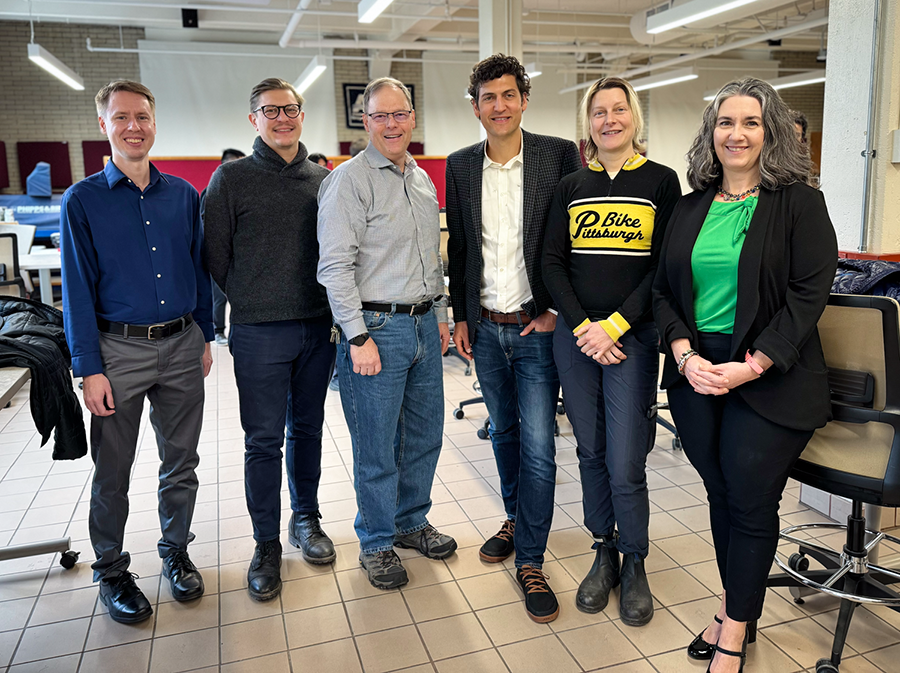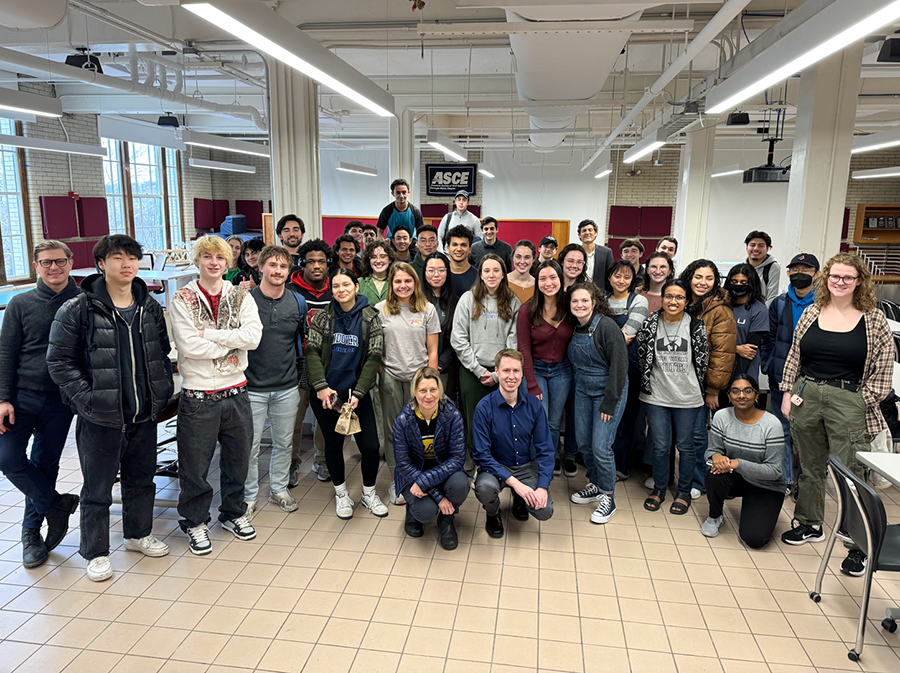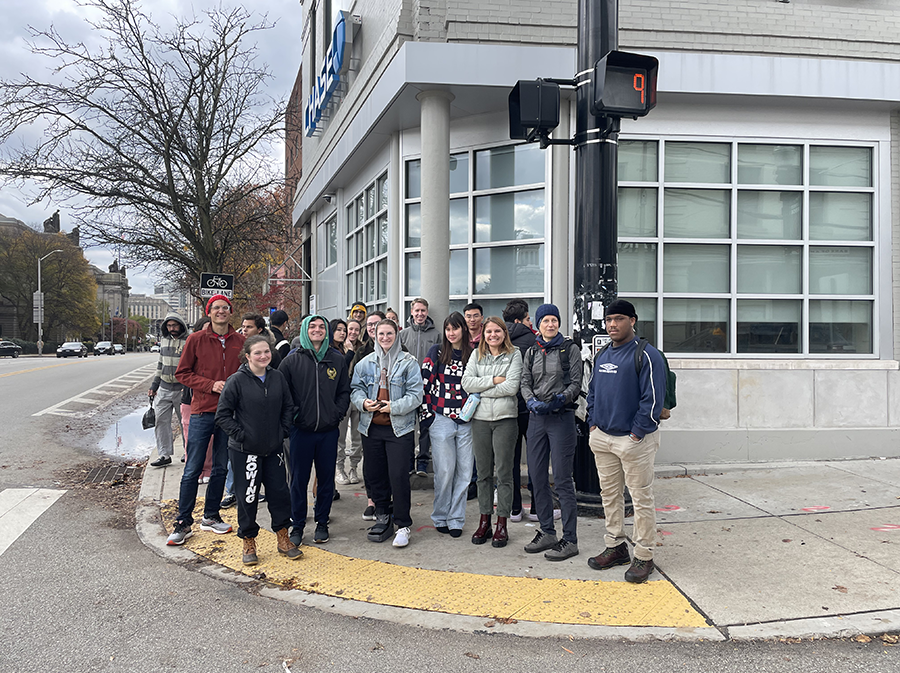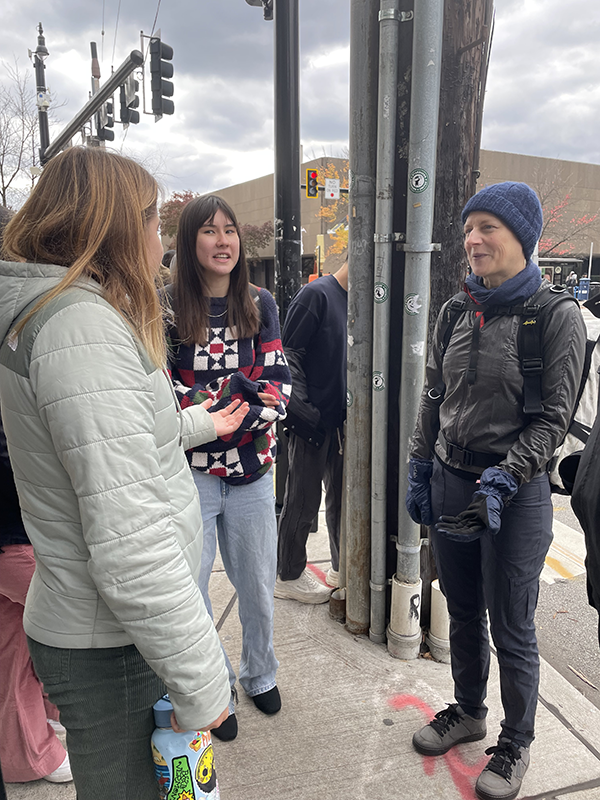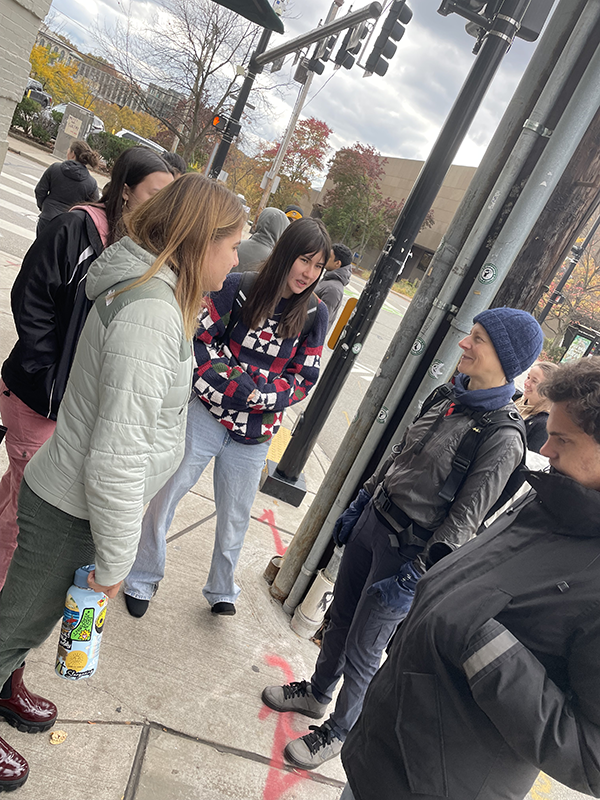Integrating the built, natural, and information environments
Civil and environmental engineering students develop improvement plans to transform congested thoroughfare into a great college town street.
At first glance, Craig Street, which connects the main thoroughfares of Forbes and Fifth Avenues in Pittsburgh’s Oakland neighborhood, appears to adequately serve the needs of the bustling university communities it serves. But when students in Carnegie Mellon’s Civil and Environmental Engineering Department Junior Projects course worked with a team of local professionals to consider ways to improve the busy two-way street, a somewhat different picture emerged.
Their assignment was to develop an improvement plan for the congested four-block span that is lined with shops, restaurants, and office buildings. In October, a class outing to observe how the street functioned revealed numerous opportunities to transform Craig Street into a great college town street.
The steady car traffic on the narrow two-way street provides little room for cyclists. Parking, which lines both sides of the street, is at a premium. The sidewalks, typically crowded with pedestrians, is too narrow to comfortably accommodate outdoor dining and has too little greenery. The entire first floor of a large office building owned by CMU is vacant. And perhaps the most glaring and immediate need for change the students saw was the busy bus stop at the corner of Forbes and Craig, which is dominated by a row of large dirty trash cans.
Joining the class outing that day were several of the professional mentors who had volunteered to work with the students. They had all been assigned to one of 10 teams, each representing a different group of stakeholders to consider in developing their improvement plans.
Todd Wilson, who earned his bachelor’s degree at Carnegie Mellon in civil and environmental engineering and engineering and public policy in 2006, was working with both the Traffic Engineering and the Roadway Safety stakeholder groups. He is a senior project manager with GAI Consultants who specializes in traffic-related civil engineering for transportation projects and has experience conducting traffic impact studies, safety audits, transit-oriented development projects, and parking studies.
“This project is remarkably similar to what we do as professionals,” said Wilson.
This would mark the fourth time that the alumnus participated in the class. His own experience as a student taking the same course inspired both his chosen profession and his enthusiasm for supporting the current College of Engineering class project.
This project is remarkably similar to what we do as professionals.
Todd Wilson, Senior Project Manager, GAI Consultants
The late John (Fred) Graham, who graduated from Carnegie Mellon in 1958 with a B.S. in civil engineering, was a professional mentor and advisor to the class when Wilson was a student. The former director of engineering and construction for Pittsburgh’s Allegheny County oversaw hundreds of bridges, more than 500 miles of roads, and the construction of the Pittsburgh International Airport during his long career.
“I was fortunate to have studied under Fred. It was clear that not only did he expect something to be done right, but he also empowered those around him to do it right,” Wilson said of Graham in a tribute he wrote about his revered mentor, who he says he admired for his ability to make tough decisions.
Two of Wilson’s colleagues from GAI Consultants were also serving as mentors. Keith Vasas worked with the Business Advocacy stakeholder group, and James Yost, mentored the Urban Planning group.
Karen Brooks, Carnegie Mellon’s Campus Bike Consultant and Corey Harper, an assistant professor in civil and environmental engineering, advised students in the Cycling stakeholder group.
Brooks not only advocates for biking on the CMU campus, but she also serves on the board of Bike Pittsburgh and belongs to the League of American Bicyclists. The organization, which was founded in 1880 to make bicycling safer and easier as a means of transportation and recreation, also rates the bike friendliness of college campuses, through its Bicycle Friendly University program.
“CMU is a silver awardee, up from its original bronze award,” explained Brooks, who says that classes such as this one that incorporate cycling into the curriculum is one of the factors the organization considers in making its awards.
Todd Reidboard, who mentored the Developer group, hosted the students at Bakery Square. He is the president of Walnut Capital, the developer of the trendy shopping and dining center, which would inspire the idea for a dining hall on Craig Street that the students dubbed Fusian Square.
Craig Toocheck, a senior planner at Pittsburgh Regional Transit advised the Transit Agency group. He appreciated that the students conducted both qualitative and quantitative analyses throughout the project.
Nizar El Daher mentored the Green Infrastructure group. He earned his Ph.D. at CMU’s School of Architecture and is the construction plans examiner for the City of Pittsburgh. Pittsburgh City Councilwoman Erika Strassburger advised the Political/Policy Stakeholders’ group, and Jen Beck from CMU was the mentor for the Student stakeholder group.
The stakeholder teams met with their mentors several times throughout the semester in order to gain a better understanding of the various Craig Street stakeholders’ needs and interests. They also spent time talking to individual stakeholders including pedestrians, cyclists ,and business owners on Craig Street.
Joe Moore, an assistant teaching professor who has taught the course for four years, was particularly impressed with the Traffic Engineering group, which independently organized their own traffic study to record the number and type of vehicles using the street.
During the end of the semester presentations, an audience member questioned the source of the traffic count data they cited. The student presenters were proud to explain that they had conducted the study themselves and arrived at the data, which revealed that from 4:25 to 5:25 p.m. on a Tuesday in early November, traffic on the four-block stretch of Craig Street, 90% of the traffic was cars; 9.2% was bikes, and 1.0% was heavy vehicles.
After having served on one of the 10 stakeholder groups, each student was then assigned to one of five teams who would work together to develop an improvement plan. The five presentation teams included members from each of the stakeholder groups, which resulted in team presentations with similar components but varying strategic approaches.
All of their visions for the reimagined street would make Craig Street a far safer, more beautiful, and welcoming destination, particularly for the college students like those who created the plans.
Several student groups favored the benefits of changing the roadway to one-way traffic and a single lane of parking so that dedicated bike lanes could be added. Elevated pervious concrete street crossings could improve stormwater management and make the street safer by more clearly indicating crosswalks for both pedestrians and drivers according to the student plans.
Student presenters also touted the benefits of enhanced lighting, signage, and wider sidewalks that could accommodate more green spaces and inviting outdoor dining options. And thanks to their visit to Bakery Square, most of the student teams suggested that a food market or dining court be opened on the vacant first floor of the CMU building, and several groups added a rooftop bar to the same upgrade plan.
Their plans were backed by research the students conducted, as well as input from the talented team of advisors, who guided the students through city ordinances and regulations, zoning considerations, commercial development issues, and National Association of City Transportation Official (NACTO) standards.
Not surprisingly, the civil engineers who are also pursuing engineering and public policy degrees were especially good at developing multiple options and weighing their merits against one another to propose the most cost-effective and feasible plan.
But perhaps the single most appealing idea that all five groups backed was moving the trash can bus stop from its existing location to a new space a short distance away in front of Tata Consultancy Services (TCS) Hall, a CMU building on Forbes Avenue.
Pictured, top: Trash cans crowd the bus stop at the corner of Forbes Avenue and Craig Street.

